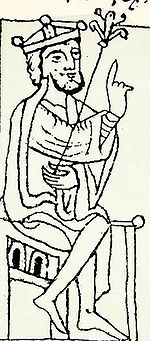Ramiro I of Aragon
| Ramiro I of Aragon | |
|---|---|
 13th century miniature of Ramiro | |
| King of Aragon | |
| Reign | 1035 - 1063 |
| Successor | Sancho Ramírez |
| Born | before 1007 |
| Died | 8 May 1063 (aged 55–56) Graus |
| Burial | |
| Spouse | Ermesinda of Bigorre Agnes |
| Issue |
|
House of Jiménez | |
| Father | Sancho III of Pamplona |
| Mother | Sancha of Aybar |
Ramiro I (bef. 1007 – 8 May 1063) was the first
Biography


Apparently born before 1007, he was the illegitimate son of Sancho III of Pamplona by his mistress Sancha of Aybar.[1] Ramiro was reputed to have been adopted by his father's wife Muniadona after he was the only one of his father's children to come to her aid when needed, although there is no surviving record of these events and the story is probably apocryphal.
During his father's reign, he appeared as witness of royal charters starting in 1011, and was given numerous properties in the
and Ramiro received lands in Aragon to hold under García.Ramiro's exact status is vague. He was called king by his vassals, neighbors, the church and even his sons, yet he always referred to himself simply as Ranimiro Sancioni regis filio (Ramiro, son of King Sancho). Likewise, in his two wills, he refers to his lands as having been given him in stewardship: in the first by García, and in the second by God. He is called regulus (rather than rex used for García) and quasi pro rege (acting as if king) in charters from Navarre.[2] Due to his growing independence and the small size of his Pyrenean holdings, he is sometimes called a "petty king", Aragon a "pocket kingdom".
Ramiro sought to enlarge his lands at the expense of both the
After annexation of Ribagorza and Sobrarbe, Ramiro began the advance from Aragon toward Huesca and Zaragoza. The first charter for the royal town of Jaca is attributed to him. It included well defined laws of protection even to non-residents, and would set an example for urban rights until late in the Middle Ages.
Ramiro died at the
Marriage and children
Before he was married, Ramiro had a mistress named Amuña (Amunna) with whom he had an illegitimate son, Sancho,[5] in whom he confided the government of the county of Ribagorza. Via a son García of Aybar and Atarés, Count Sancho was grandfather of Pedro de Atarés, a candidate to succeed Alfonso the Battler.
Ramiro's first wife was
- Sancho Ramírez, his successor
- García, Bishop of Jaca
- Armengol III of Urgelin 1065
- Urraca, nun in Santa Cruz de la Serós
- Theresa, who married William Bertrand of Provence[7]
Ramiro's second wife was Agnes (Inés), perhaps a daughter of the Duke of Aquitaine. No children are known from this marriage.
References
- ^ The Crónica de Aragón, produced in 1499, names her Doña Caya, but she is named Sancha in a contemporary donation. Ballesteros y Beretta, v. 2, pp. 319–320.
- ^ Ubieto Arteta, pp. 175–178; Nelson, pp. 228-229.
- ^ Ubieto Arteta, pp. 169–173
- ^ Richard Fletcher, The Quest for El Cid, (Oxford University Press, 1989), 113.
- ^ Balaguer, 239–242
- ^ Bernard F. Reilly, The Contest of Christian and Muslim Spain 1031-1157, (Blackwell Publishers Inc., 1995), 71.
- ^ Nelson 1991, p. 17.
Sources
- Ávila Seoane, Nicolás (2016). Intitulación y data con los hijos de Sancho III el Mayor (PDF). Colección Monofráficas de la Sociedad Española de Estudios Medievales (in Spanish). Madrid: CSIC. ISBN 978-84-945433-1-9.
- Balaguer, Federico (1960). "Doña Amuña: un amor juvenil de Ramiro I de Aragon" (PDF). Argensola: Revista de Ciencias Sociales del Instituto de Estudios Altoaragoneses (43): 239–242.
- Ballesteros y Beretta, Antonio (1920). Historia de España y su influencia en la historia universal (in Spanish). Barcelona: Salvat. OCLC 163181517.
- ISBN 9780404014797.
- Lourie, Elena (October 1975). "The Will of Alfonso I, 'El Batallador', King of Aragon and Navarre: A Reassessment". S2CID 159659007.
- Nelson, Lynn (1983). "The Aragonese Acquisition of Sobrarbe and Ribagorza". Estudios en homenaje a Don Claudio Sánchez Albornoz en sus 90 years. Vol. II. Buenos Aires: Instituto de Historia de España. pp. 227–236. OCLC 13009842.
- Nelson, Lynn H., ed. (1991). The Chronicle of San Juan de la Peña: A Fourteenth-century Official History of the Crown of Aragon. University of Pennsylvania Press.
- Ubieto Arteta, Antonio (1960a). "Estudios en torno a la división del Reino por Sancho el Mayor de Navarra" (PDF). Príncipe de Viana (in Spanish). No. Year 21, No. 78-79. pp. 5–26. ISSN 0032-8472.
- Ubieto Arteta, Antonio (1960b). "Estudios en torno a la división del Reino por Sancho el Mayor de Navarra" (PDF). Príncipe de Viana (in Spanish). No. Year 21, No. 80-81. pp. 163–236. ISSN 0032-8472.
- Viruete Erdozáin, Roberto (2008). Aragón en la época de Ramiro I (in Spanish). Zaragoza: Universidad de Zaragoza. ISBN 978-84-692-2032-0.
- Viruete Erdozáin, Roberto (2013). La colección diplomática del reinado de Ramiro I de Aragón (1035–1064) (PDF). Fuentes históricas aragonesas (66) (in Spanish). Zaragoza: Institución Fernando el Católico (C.S.I.C.). Excma. Diputación de Zaragoza. ISBN 9788499112190.

